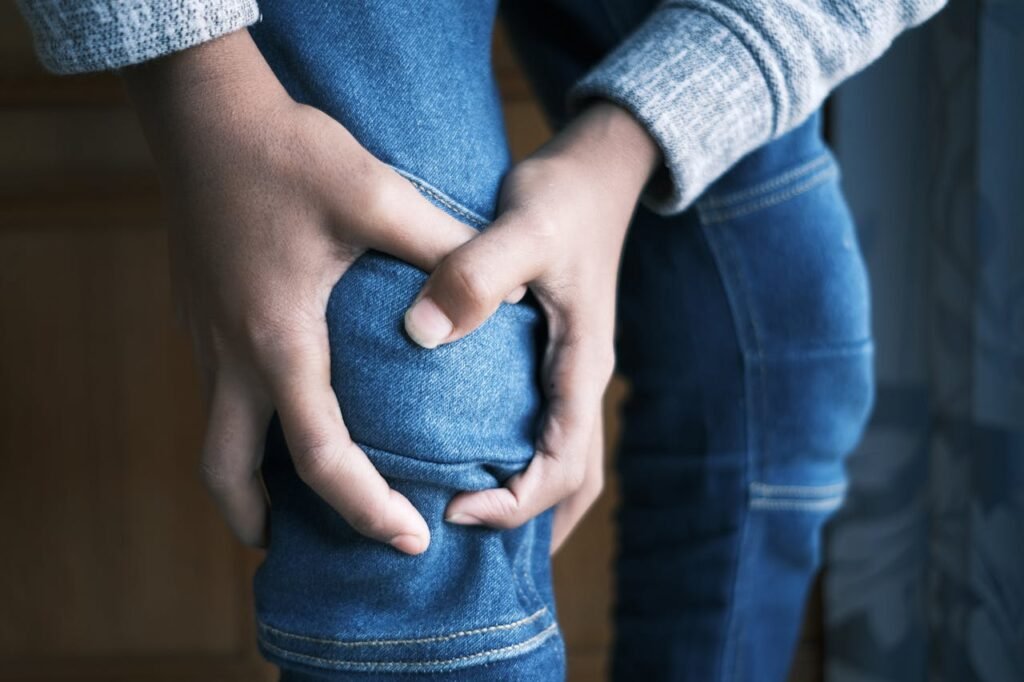Understanding Knee Pain in Aging Adults
Knee pain at night as well as in knee pain in general emerges as a prevalent issue in aging adults due to a variety of anatomical and physiological changes. As individuals age, the knee joint, which is a complex assembly of bones, cartilage, ligaments, and tendons, undergoes significant wear and tear. This complex structure facilitates essential functions such as movement and weight-bearing; however, it is also highly susceptible to the degenerative processes associated with aging.
Central to the knee joint’s functionality is the cartilage. This smooth, resilient tissue covers the articulating surfaces of the bones, reducing friction and absorbing shock during movement. With advancing age, cartilage tends to lose its elasticity and thickness, leading to increased friction and joint damage. This phenomenon is exacerbated by decreased production of synovial fluid, which normally lubricates the joint, contributing to the stiffness often reported in knee pain at night.
The ligaments and tendons surrounding the knee also suffer the brunt of aging. These structures lose their tensile strength and flexibility over time, rendering them more prone to injuries and contributing to instability of the knee joint. Ligament degeneration can lead to compromised support around the knee, making daily activities more challenging and painful for older adults.
Among the most common conditions causing knee pain in aging adults are osteoarthritis and degenerative joint disease. Osteoarthritis, a leading contributor, is characterized by the gradual degeneration of cartilage, which ultimately leads to bone-on-bone contact, causing significant pain and discomfort. Degenerative joint disease similarly involves the breakdown of joint structures, further fueling knee pain symptoms.
In summary, knee pain in aging adults results from a combination of anatomical degradation and physiological decline. The complex interplay of diminishing cartilage, weakening ligaments, and the onset of conditions like osteoarthritis underscores the multifaceted nature of this health concern. Understanding these underlying factors lays the groundwork for identifying effective management and treatment strategies tailored to mitigate knee pain as people age.
Common Symptoms and Diagnosis of Knee Pain
Knee pain, particularly at night, commonly begins through a variety of symptoms that can significantly impact a person’s daily life and overall mobility. Typical symptoms include stiffness, which can be particularly pronounced after periods of inactivity or upon waking. Swelling around the knee joint is another common indicator, often accompanied by warmth and redness, signaling inflammation. Reduced range of motion is also a prominent symptom, making activities that require bending or straightening the knee challenging and uncomfortable.
Accurate diagnosis of knee pain is essential for effective management and treatment. Healthcare providers typically start with a comprehensive patient history and physical examination. They will inquire about the onset and nature of the knee pain, its frequency, and any activities that exacerbate or relieve the symptoms. During the physical examination, doctors assess the knee’s appearance, look for signs of swelling, and evaluate the range of motion. They may also check for tenderness, warmth, and any abnormal sounds, such as creaking or popping, during knee movements.
To gain a more detailed understanding of the underlying causes of knee pain as well as joint pain, especially those that might not be evident through a visual examination, imaging tests are often employed. X-rays can reveal bone abnormalities, fractures, and arthritis-related changes. For a more comprehensive assessment, Magnetic Resonance Imaging (MRI) is used to inspect soft tissues, including cartilage, ligaments, tendons, and muscles. In some cases, doctors may also recommend ultrasound or CT scans for additional insights.
Early diagnosis plays a crucial role in managing knee pain effectively. Addressing the symptoms at an initial stage can prevent further deterioration and facilitate more successful interventions. By understanding the specific causes and characteristics of the pain, healthcare providers can devise personalized treatment plans aimed at alleviating discomfort and restoring mobility.
Lifestyle Modifications to Alleviate Knee Pain
Maintaining an active and healthy lifestyle is fundamental in managing knee pain, especially as we age. One of the pivotal factors is maintaining a healthy weight. Excess body weight can place additional pressure on the knees, amplifying discomfort and potentially accelerating the wear and tear of joint cartilage. Engaging in a balanced diet that is rich in nutrients and low in processed foods can help achieve and sustain an optimal weight, thereby alleviating strain on the knees.
Adapting to low-impact exercises such as swimming, cycling, or walking can also significantly reduce knee pain at night. Unlike high-impact activities like running or jumping, low-impact exercises minimize stress on already sensitive joints while keeping the muscles around the knees strong. Swimming, in particular, offers a full-body workout without putting pressure on the knees, making it an excellent choice for those seeking to stay fit while managing knee pain.
Incorporating stretching and strength training into daily routines is another critical strategy. Stretching exercises help maintain flexibility and improve range of motion, potentially reducing stiffness and increasing comfort during nighttime. Regular strength training, focusing on the leg muscles, can enhance muscle support around the knee joint, providing greater stability and reducing the likelihood of injury.
Finally, staying active is paramount for joint health. Prolonged periods of inactivity can lead to stiffness, which can exacerbate knee pain. Engaging in regular physical activity not only maintains joint flexibility but also promotes overall well-being. Integrating these lifestyle modifications can create a holistic approach to managing knee pain as we age, ensuring a more comfortable and active life.
Over the Counter and Prescription Medications
Managing knee pain night or day often involves the use of over the counter and prescription medications. For many individuals, readily available options such as acetaminophen and nonsteroidal anti-inflammatory drugs (NSAIDs) like ibuprofen or naproxen can provide substantial relief. These medications work by reducing inflammation and alleviating pain, making them a common first step in addressing knee discomfort.
Acetaminophen is generally known for its pain-relieving properties without significant anti-inflammatory action. This makes it a suitable choice for those unable to tolerate NSAIDs due to gastrointestinal side effects. On the other hand, NSAIDs not only help in managing pain but also tackle inflammation, which can be particularly beneficial for conditions like arthritis.
For more severe or persistent knee pain, healthcare providers may prescribe stronger medications. Prescription-strength NSAIDs or opioids may be considered, although the latter are typically reserved for short-term use due to their risk of dependency. Another option includes corticosteroids, which can be administered orally or via injection directly into the knee joint. These steroids help reduce inflammation rapidly and provide relief; however, repeated use is generally discouraged to avoid potential side effects such as joint damage or weakening of surrounding tissues.
It is imperative to understand the potential side effects associated with these medications. Over-the-counter NSAIDs, for instance, can lead to gastrointestinal issues, cardiovascular problems, and kidney damage if used excessively. Corticosteroids, while effective, can cause elevated blood sugar levels, weight gain, and increased susceptibility to infections. Consulting with healthcare providers is crucial to ensure the chosen medication aligns with one’s overall health profile and avoids adverse interactions with other treatments.
Hence, over the counter and prescription medications form a pivotal part of managing knee pain, allowing individuals to maintain mobility and improve their quality of life. Carefully considering the type and duration of medication use, in consultation with healthcare professionals, ensures optimal and safe pain management.
Physical Therapy and Rehabilitation
As individuals age, the importance of effective management strategies for knee pain, particularly knee pain at night, cannot be overstated. Physical therapy emerges as a critical component in alleviating discomfort and enhancing knee function. Skilled physical therapists design personalized exercise programs tailored to the needs of each patient. These programs are fundamental in boosting joint function, enhancing muscle strength, and notably minimizing pain.
The essence of physical therapy lies in its customized approach. For those contending with knee pain, including nocturnal knee discomfort, therapists often incorporate a variety of exercises aimed at bolstering the muscles surrounding the knee joint. Strength exercises like leg raises, hamstring stretches, and quadriceps sets fortify the muscles, thereby reducing the strain on the knee joint itself. This targeted strengthening is invaluable not only in pain management but also in preventing future injuries.
Moreover, flexibility exercises play a vital role in improving knee health. Techniques such as calf stretches and heel slides enhance the range of motion, which can significantly alleviate stiffness and contribute to more fluid movement. These exercises, consistently practiced, can make a marked difference in an individual’s ability to perform daily activities without discomfort or interruption.
Another pivotal aspect of physical therapy is its role in post-operative rehabilitation. For patients recovering from knee surgeries, structured rehabilitation programs are indispensable. Gradual, supervised exercises help restore knee function, accelerate recovery, and prevent complications. The combination of strength training, flexibility work, and functional exercises ensures a comprehensive recovery process, laying the groundwork for long-term knee health.
Ultimately, the targeted interventions provided by physical therapy offer a sustainable solution to managing knee pain, particularly during the night. These specialized programs are designed not just to address immediate pain but also to foster resilience, ensuring that individuals can maintain a higher quality of life as they age.
Surgical Options for Severe Knee Pain
For individuals experiencing chronic or severe knee pain, surgical intervention may become a necessary course of action. The decision to undergo surgery is typically considered when conservative treatments, such as physical therapy and medication, have proven ineffective. Three primary surgical options are commonly recommended based on the specific condition and severity of the knee pain: arthroscopy, partial knee replacement, and total knee replacement.
Arthroscopy is minimally invasive and utilized to diagnose and treat joint issues. Small incisions allow the insertion of a camera and instruments to address concerns like torn meniscus, damaged cartilage, or inflamed synovial tissue. This procedure often results in a quicker recovery period, with patients resuming normal activities within weeks. However, it may not be suitable for those with advanced knee degeneration.
Partial knee replacement, also known as unicompartmental knee arthroplasty, is an option when knee damage is confined to one compartment. This procedure involves replacing only the affected part of the knee, preserving healthy bone and tissue. Candidates for partial knee replacement often experience faster recovery and more natural knee function post-surgery. However, the long-term success of this procedure is dependent on the overall condition of the knee.
Total knee replacement, or total knee arthroplasty, becomes necessary when knee pain night and day significantly affects the quality of life, and extensive damage encompasses the entire knee joint. The procedure involves replacing the knee joint with artificial components made from metal and plastic. Although recovery can take several months and requires intensive physical therapy, many patients gain substantial pain relief and improved mobility.
It is essential for patients to understand the potential risks associated with knee surgery, which include infection, blood clots, and complications from anesthesia. Furthermore, postoperative performance can vary based on individual health factors and overall physical condition. A detailed discussion with an orthopedic surgeon can help determine the most suitable surgical option, ensuring an informed decision aligned with the patient’s specific needs and lifestyle.
Alternative and Complementary Therapies
As conventional medical treatments sometimes fall short in addressing knee pain, many individuals turn to alternative and complementary therapies for relief. Among these, acupuncture has emerged as a prominent choice. Rooted in ancient Chinese medicine, acupuncture involves inserting fine needles into specific points on the body to stimulate healing and reduce pain. Several studies suggest that acupuncture can be effective in mitigating knee pain, particularly at night, when symptoms might intensify.
Chiropractic care is another widely sought-after remedy. This therapy focuses on the diagnosis and treatment of musculoskeletal disorders, primarily through manual adjustment and manipulation of the spine. By realigning the body’s structure, chiropractic care aims to foster better joint function and alleviate pain. Many patients report significant improvements in knee pain after chiropractic sessions, though it is essential to approach this treatment under professional guidance.
Herbal supplements are also gaining traction as a natural means to manage knee pain. Supplements such as turmeric and glucosamine have been noted for their anti-inflammatory and joint-supportive properties. While scientific evidence varies, anecdotal accounts and some clinical studies suggest positive outcomes in reducing knee discomfort, especially at night when inflammation can peak.
Newer approaches like Platelet-Rich Plasma (PRP) injections and stem cell therapy are making strides in the realm of knee pain treatment. PRP therapy involves concentrating platelets from the patient’s blood and injecting them into the knee to accelerate healing. Similarly, stem cell therapy aims to regenerate damaged tissues and improve joint health. Both treatments show promise, but they are still under research and not universally available.
It is imperative to consult healthcare providers before embarking on any alternative treatment plan. While these therapies may offer relief, their suitability varies significantly from person to person. Proper medical guidance ensures that these interventions are safe and tailored to an individual’s specific health needs, providing a balanced and holistic approach to managing knee pain at night and beyond.
Preventive Measures and Long-Term Management
Preventing knee pain and managing it over the long term is crucial for maintaining mobility and quality of life, especially as people age. One of the most effective strategies for warding off knee pain at night and during the day is wearing proper footwear. Shoes with adequate arch support, cushioning, and a good fit can significantly reduce stress on the knee joints. Athletic shoes designed for specific activities, such as running or walking, can also provide additional support tailored to your movements.
Role of nutrition in joint health cannot be overstated. Consuming a balanced diet rich in vitamins and minerals supports joint health and can mitigate knee pain. Nutrients like omega-3 fatty acids found in fish, antioxidants found in fruits and vegetables, and calcium for bone health are particularly important. Supplements such as glucosamine and chondroitin may also be beneficial, but it’s advisable to consult with a healthcare provider before beginning any new regimen.
Joint-protection techniques are another cornerstone in preventing knee pain. Activities that put excessive strain on the knees, such as high-impact sports, should be approached cautiously. Adopt low-impact alternatives like swimming or cycling that provide excellent cardiovascular benefits without excessive pressure on the knee joints. Additionally, incorporating strength training, particularly exercises that focus on quadriceps and hamstrings, can offer better support to the knees, thereby reducing pain.
Regular check-ups with healthcare providers are essential for long-term knee health. Screening for knee-related issues can catch problems early, allowing for timely adjustments to treatment plans. Regular follow-ups ensure that any evolving concerns are addressed promptly, and they provide an opportunity to update your care plan, whether it involves physical therapy, medication, or lifestyle changes.
By combining appropriate footwear, supportive nutrition, joint-friendly activities, and regular medical consultations, individuals can significantly improve their knee pain especially at night. These strategies prevent knee pain from becoming a chronic issue, thus enhancing overall well-being and mobility.



